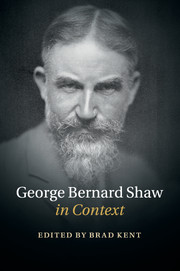Book contents
- Frontmatter
- Dedication
- Contents
- List of illustrations
- Notes on contributors
- Preface
- Acknowledgements
- A Chronology of Shaw's Works
- List of abbreviations
- PART I PEOPLE AND PLACES
- PART II THEATRE
- PART III WRITING AND THE ARTS
- 15 Cinema
- 16 Journalism
- 17 Letters
- 18 Media and technology
- 19 Modernism
- 20 Music
- 21 Novels
- 22 Publishers and publishing
- 23 Visual arts
- PART IV POLITICS
- PART V CULTURE AND SOCIETY
- PART VI RECEPTION AND AFTERLIFE
- Further reading
- Index
- References
18 - Media and technology
from PART III - WRITING AND THE ARTS
Published online by Cambridge University Press: 05 October 2015
- Frontmatter
- Dedication
- Contents
- List of illustrations
- Notes on contributors
- Preface
- Acknowledgements
- A Chronology of Shaw's Works
- List of abbreviations
- PART I PEOPLE AND PLACES
- PART II THEATRE
- PART III WRITING AND THE ARTS
- 15 Cinema
- 16 Journalism
- 17 Letters
- 18 Media and technology
- 19 Modernism
- 20 Music
- 21 Novels
- 22 Publishers and publishing
- 23 Visual arts
- PART IV POLITICS
- PART V CULTURE AND SOCIETY
- PART VI RECEPTION AND AFTERLIFE
- Further reading
- Index
- References
Summary
Shaw belongs to an age of mechanical reproducibility. His contemporaries thought of him as a human-machine hybrid: he reminded W. B. Yeats of a monstrous smiling sewing machine, Max Beerbohm of a steamship, and William Archer once described him as a Nietzschean motor car that ran down late Victorian playwrights. Shaw actively sought to be broadcast by film and radio: in 1924, he performed all the parts in a BBC radio production of O'Flaherty, V.C.; and he greeted American audiences in cinemas in a 1928 newsreel by mocking Mussolini's incomprehensible MovieTone appearance the year before, demonstrating his puckish command of mass media by showing how, unlike the stony dictator, he could ‘put on’ and ‘take off ’ any face he chose.
Shaw was an early adopter of late Victorian and modernist technologies that promised to make communication easier and to bridge distances in time and space. He bought a typewriter on credit in 1890 and, after reviewing several photographic exhibitions, a camera in 1898. He placed a motor car on stage in Man and Superman in 1903, five years before Ford's Model T became the first widely affordable automobile. In Shaw's 1911 play, Misalliance, an aeroplane crashes through a glass pavilion on a country estate two years after Louis Blériot completed the first flight across the English Channel in a heavier-than-air aircraft.
As a playwright and a theorist of media use and transition, Shaw shaped the reciprocal relationship between representation and conduct during the emergence of new recording, playback, and broadcasting technologies. In his 1898 Preface to Plays Unpleasant, for example, Shaw proposed the published play as a ‘new art’ (CPP I: 31) that he had inaugurated through innovative methods of dramatic notation like novelistic scene descriptions in place of ‘repulsive stage technicalities’. Modelled partially on William Morris’ Kelmscott Press books, which foregrounded the material beauty of the book, Shaw's printed plays tinker with the dramatic script as a medium: after adjustment into a mass media form, plays can enjoy broader circulation – ‘For the sake of the unhappy prisoners of the home, then, let my plays be distributed as well as acted’ (CPP I: 25) – and can become reliable vessels of a writer's, rather than an actor's, artistry.
- Type
- Chapter
- Information
- George Bernard Shaw in Context , pp. 143 - 150Publisher: Cambridge University PressPrint publication year: 2015



